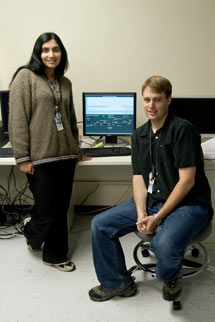
Handy Links
SLAC News Center
SLAC Today
- Subscribe
- Archives: Feb 2006-May 20, 2011
- Archives: May 23, 2011 and later
- Submit Feedback or Story Ideas
- About SLAC Today
SLAC News
Lab News
- Interactions
- Lightsources.org
- ILC NewsLine
- Int'l Science Grid This Week
- Fermilab Today
- Berkeley Lab News
- @brookhaven TODAY
- DOE Pulse
- CERN Courier
- DESY inForm
- US / LHC
SLAC Links
- Emergency
- Safety
- Policy Repository
- Site Entry Form

- Site Maps
- M & O Review
- Computing Status & Calendar
- SLAC Colloquium
- SLACspeak
- SLACspace
- SLAC Logo
- Café Menu
- Flea Market
- Web E-mail
- Marguerite Shuttle
- Discount Commuter Passes
-
Award Reporting Form
- SPIRES
- SciDoc
- Activity Groups
- Library
Stanford
Around the Bay
Live from the Main Control Center: The LCLS Real Time Display
Software engineers with the Experimental Physics and Industrial Control Systems Group in the SLAC Controls Department unveiled the Linac Coherent Light Source Real Time 24 Hour Display last week, giving all SLAC employees and on-site users access to real-time status updates on the LCLS X-ray beam.
The display, which is available to anyone accessing the Web from a SLAC computer, was designed to provide lab administrators with summary information on the status of the LCLS beam. According to EPICS Group Leader Ernest Williams, the display gives lab administrators an at-a-glance summary of facility performance.
"Management wants to know 'how's the machine running today?'" Williams said. "Engineers can use this kind of thing too, but the target audience is the management."
To see the display, on a computer within the SLAC intranet, copy and paste the following URL into the Firefox browser:
http://www.slac.stanford.edu/grp/cd/soft/images/slaconly/LCLS-24HrSummary.xhtml
The display was created over the last two and-a-half-months by EPICS Control Systems Engineer Matt Boyes, Main Control Center Area Manager William Colocho and Vidya Kumar, a summer intern who has been working with the Controls Department since August. The display includes characteristics of the LCLS beam over the last 24 hours, including the energy level, charge level and the number of photons in each X-ray pulse.
According to Boyes, the system is a big improvement over previous Web-based displays, which have worked by taking screenshots of the LCLS 24-hour summary display shown in the Main Control Center and periodically updating the image.
Using a programming language called Channel Access Markup Language, the new system communicates with the LCLS control center directly, allowing it to provide real time data. According to Boyes, the system has the added benefit of being a lot more flexible, meaning that as things are refined, it could be used to deliver other kinds of information as well.
"If we want to have more diagnostics for physicists and technicians we can," Boyes said. "We could, in the future, have more of the control system's screens on the Web."
According to Williams, additional screens could be used to provide engineers with displays on things like beamline vacuum and undulator average temperature.
Because of browser requirements, the display is only available using Firefox on machines running Windows. Boyes said that making the display more accessible will be the main focus in the project over the coming months.
"This project for the LCLS summary is just the first step," Boyes said
—Nicholas Bock
SLAC Today, November 10, 2009
